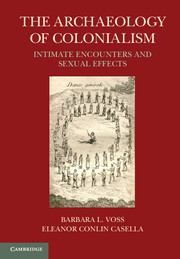Book contents
- Frontmatter
- Contents
- List of Illustrations
- List of Tables
- List of Contributors
- One Intimate Encounters
- Two Sexual Effects
- Section I Pleasures and Prohibitions
- Section II Engaged Bodies
- Section III Commemorations
- Twelve Life and Death in Ancient Colonies
- Thirteen Reading Gladiators’ Epitaphs and Rethinking Violence and Masculinity in The Roman Empire
- Fourteen Monuments and Sexual Politics in New England Indian Country
- Fifteen Gender Relations in A Maroon Community, Palmares, Brazil
- Section IV Showing and Telling
- Conclusion
- Index
- References
Thirteen - Reading Gladiators’ Epitaphs and Rethinking Violence and Masculinity in The Roman Empire
from Section III - Commemorations
Published online by Cambridge University Press: 05 June 2012
- Frontmatter
- Contents
- List of Illustrations
- List of Tables
- List of Contributors
- One Intimate Encounters
- Two Sexual Effects
- Section I Pleasures and Prohibitions
- Section II Engaged Bodies
- Section III Commemorations
- Twelve Life and Death in Ancient Colonies
- Thirteen Reading Gladiators’ Epitaphs and Rethinking Violence and Masculinity in The Roman Empire
- Fourteen Monuments and Sexual Politics in New England Indian Country
- Fifteen Gender Relations in A Maroon Community, Palmares, Brazil
- Section IV Showing and Telling
- Conclusion
- Index
- References
Summary
Introduction
Classical sources have been used to provide broad parallels and contrasts with the present. Although many types of archaeological and historical information are available about the Roman Empire, Hingley (2005) states that a core issue in modern scholarship is how to approach the relationship between power and identity. Since the sixteenth century, the Romans sometimes have been understood to be part of a shared European identity; conversely, at times the Romans were categorized as “others.” Roman violence and power have both attracted and repulsed scholars throughout the past two centuries, resulting in different interpretations of the Roman past. For example, the consequences of Roman imperialism have been understood at times as beneficial to native societies because of supposed material improvement and cultural “progress” experienced by native societies. The Roman system of domination, therefore, became an example of what a modern empire should be and consequently inspired colonialist policy during the end of nineteenth century into the beginning of twentieth, with the violence of the process seldom acknowledged (Hingley 1996, 2000, 2001, 2005, Shepherd, Chapter 17, this volume).
In the 1970s, however, this perception of the Roman Empire began to be challenged. The so-called nativist approach, developed mainly by British scholars, pointed out the importance of material culture in the study of local communities. This new scholarship balanced the record of the elite with an awareness of cultural negotiation in different areas of the empire (Delgado and Ferrer, Chapter 12, this volume). This approach emphasizes that native people were not only “assimilated” into the Roman order but also participated in the creation of new orders.
- Type
- Chapter
- Information
- The Archaeology of ColonialismIntimate Encounters and Sexual Effects, pp. 214 - 231Publisher: Cambridge University PressPrint publication year: 2011



